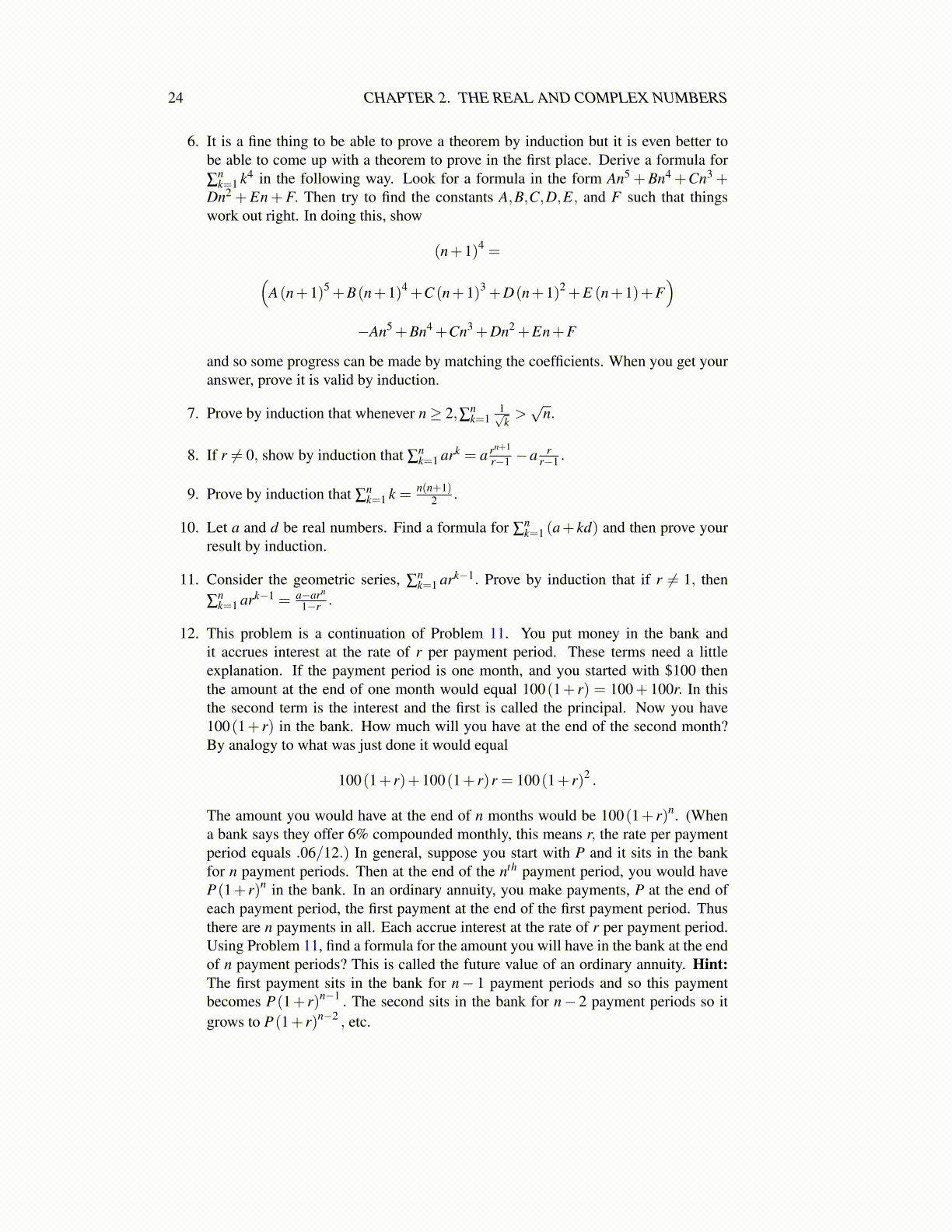
24 CHAPTER 2. THE REAL AND COMPLEX NUMBERS
9. Prove by induction that ∑nk=1 k = n(n+1)
2 .
10. Let a and d be real numbers. Find a formula for ∑nk=1 (a+ kd) and then prove your
result by induction.
11. Consider the geometric series, ∑nk=1 ark−1. Prove by induction that if r ̸= 1, then
∑nk=1 ark−1 = a−arn
1−r .
12. This problem is a continuation of Problem 11. You put money in the bank andit accrues interest at the rate of r per payment period. These terms need a littleexplanation. If the payment period is one month, and you started with $100 thenthe amount at the end of one month would equal 100(1+ r) = 100+ 100r. In thisthe second term is the interest and the first is called the principal. Now you have100(1+ r) in the bank. How much will you have at the end of the second month?By analogy to what was just done it would equal
100(1+ r)+100(1+ r)r = 100(1+ r)2 .
The amount you would have at the end of n months would be 100(1+ r)n. (Whena bank says they offer 6% compounded monthly, this means r, the rate per paymentperiod equals .06/12.) In general, suppose you start with P and it sits in the bankfor n payment periods. Then at the end of the nth payment period, you would haveP(1+ r)n in the bank. In an ordinary annuity, you make payments, P at the end ofeach payment period, the first payment at the end of the first payment period. Thusthere are n payments in all. Each accrue interest at the rate of r per payment period.Using Problem 11, find a formula for the amount you will have in the bank at the endof n payment periods? This is called the future value of an ordinary annuity. Hint:The first payment sits in the bank for n− 1 payment periods and so this paymentbecomes P(1+ r)n−1 . The second sits in the bank for n− 2 payment periods so itgrows to P(1+ r)n−2 , etc.
13. Now suppose you want to buy a house by making n equal monthly payments. Typi-cally, n is pretty large, 360 for a thirty year loan. Clearly a payment made 10 yearsfrom now can’t be considered as valuable to the bank as one made today. This is be-cause the one made today could be invested by the bank and having accrued interestfor 10 years would be far larger. So what is a payment made at the end of k paymentperiods worth today assuming money is worth r per payment period? Shouldn’t itbe the amount, Q which when invested at a rate of r per payment period would yieldP at the end of k payment periods? Thus from Problem 12 Q(1+ r)k = P and soQ = P(1+ r)−k . Thus this payment of P at the end of n payment periods, is worthP(1+ r)−k to the bank right now. It follows the amount of the loan should equalthe sum of these “discounted payments”. That is, letting A be the amount of theloan, A = ∑
nk=1 P(1+ r)−k . Using Problem 11, find a formula for the right side of
the above formula. This is called the present value of an ordinary annuity.
14. Suppose the available interest rate is 7% per year and you want to take a loan for$100,000 with the first monthly payment at the end of the first month. If you want topay off the loan in 20 years, what should the monthly payments be? Hint: The rateper payment period is .07/12. See the formula you got in Problem 13 and solve forP.